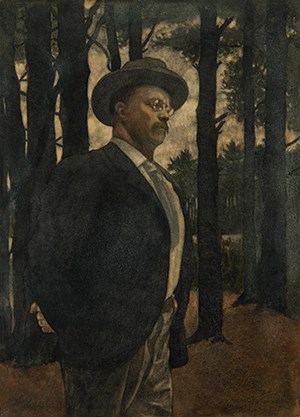
Eleanor Roosevelt entertained family and friends in the living room, often gathered around the fireplace for lively conversation. Eleanor would read poetry, aloud, perhaps from her much used copy of Home Book of Verse. Before moving her office to the rooms formerly occupied by her secretary Malvina Thompson, Eleanor kept a large desk in the alcove, where she would work, looking out over a view of the pond. In later years, she would serve tea in the alcove to Senator John F. Kennedy, who paid a visit here in 1960 seeking Eleanor Roosevelt's endorsement for his presidential campaign. Furnishings of Note
Portrait of Theodore RooseveltThis watercolor portrait of Theodore Roosevelt was painted around 1901 by Charles William Hudson (1871-1943), just at the time Theodore Roosevelt (1858-1919) assumed the office of President of the United States following William McKinley's assasination. Roosevelt was Eleanor's uncle, and brother of her father Elliott Roosevelt (1860-1894). Despite political differences that caused some family members to actively campaign against one another, Theodore Roosevelt was extrememly fond of his neice Eleanor. Charles Hudson studied painting at the Boston Museum of Fine Arts and is know primarily as a landscape painter. 
Stained Glass MedallionThis stained glass flor medallion is by American artist Sarah Wyman Whitman (1842-1904). Whitman was a successful stained glass artist, painter, and book cover designer at a time when few women had professional art careers. Her stained glass windows are found in churches and colleges throughout the northeastern United States. 
Rubaiyat Wall HangingBlock print cotton textile wall hanging, Rubaiyat, by Barbara Warren, Milwaukee Handicraft Project. In November of 1936, Eleanor Roosevelt visited the Milwaukee Handicraft Project, a WPA program developed to train the unemployed with skills by which they could earn a living. The workers produced books, toys, furniture, and textiles. These products were used to furnish schools, nurseries, hospitals, colleges, and a range of state and county institutions all over the country. On the occasion of her visit, Mrs. Roosevelt was presented with several block printed textiles. Among them was Barbara Warren’s Rubaiyat, which she installed in her living room at Val-kill. |
Last updated: May 12, 2023
